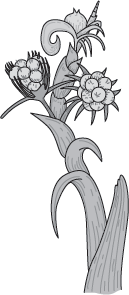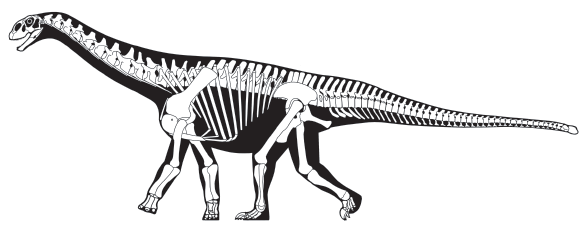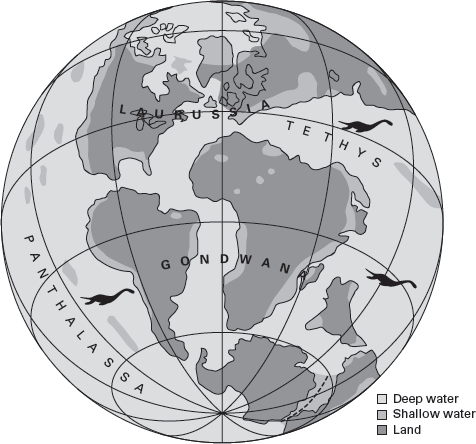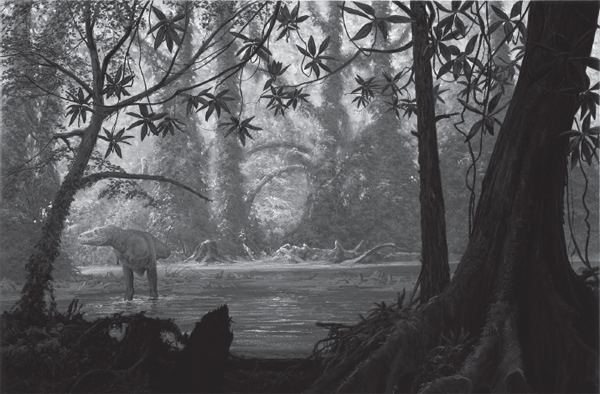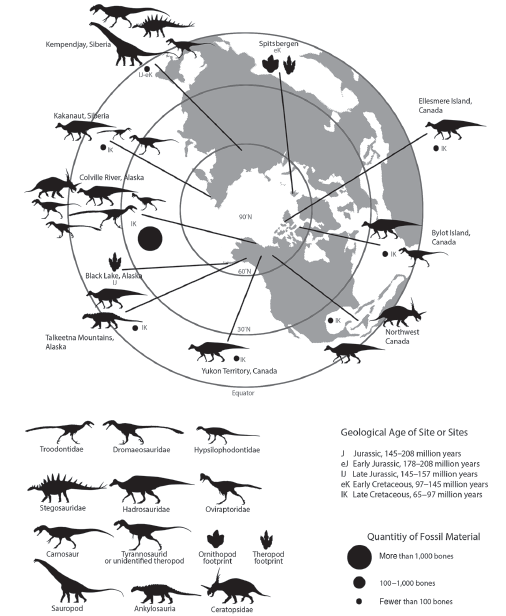DINOSAURS existed for about 160 million years, from the Late Triassic, 225 to 230 million years ago, to the end of the Cretaceous, 66 million years ago. This interval of time can be called the “age of dinosaurs,” whereas the entire Mesozoic Era is usually termed the “age of reptiles.”
Dinosaurs did not live and evolve in isolation during the age of dinosaurs. They coexisted with plants and other animals in climates and on landscapes very different from those of today. Furthermore, dinosaurs changed dramatically—through evolution and extinction—during the age of dinosaurs. This chapter examines these changes and briefly reviews the geography, climate, vegetation, and animal life that made up the dinosaurian world.
Earth’s crust is made up of rigid plates that move, thereby changing the distribution of land and sea during geological time (
figure 10.1). This movement, popularly called continental drift (though not only the continents move), has a profound effect on both global sea level and climate.
The continents drift because rising heat forms long uplifted ridges on the floors of the ocean basins (see
figure 10.1). These ridges are made of lava being pushed out of the Earth’s interior. The new lava flows down the ridge slopes, forcing the oceanic crust away from the ridge axis and thus widening the ocean basin. The oceanic crust collides with continental crust and thus moves the continent. At the point of any crustal collision, mountain ranges form—they are the crumpled crust at the point of impact.
The process of seafloor spreading can change the volume of an ocean basin. Thus, when much heat is released from the Earth’s interior, the mid-oceanic ridge is very large, and the volume of the ocean basin is reduced. The water from the basin must go somewhere, so it is forced out onto the continents, drowning what was once dry land. In this way, at times of increased heat release, sea level is relatively high because much of the water in the ocean basins is being spilled onto the continents. The Cretaceous was such a time, with very high sea levels and much of the world’s continents under seawater. In contrast, the Triassic was a time of low sea levels when most of the continents were dry land. The Jurassic was an intermediate phase between the Triassic and Cretaceous extremes.
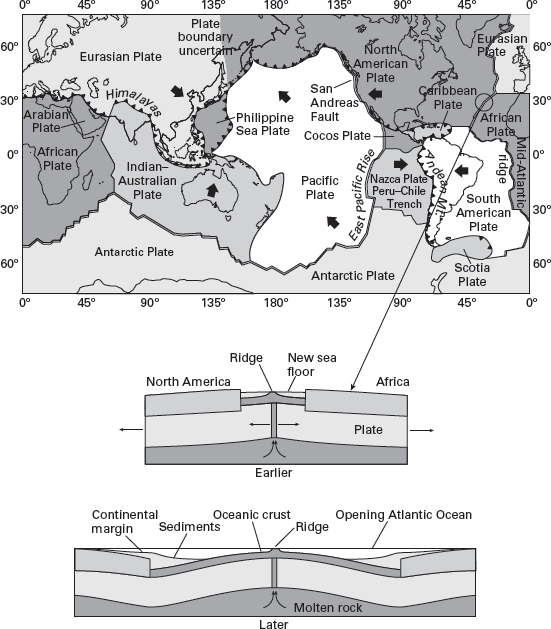
FIGURE 10.1
The Earth’s crust is made of plates that move as ocean basins are opened (above). Heat and molten rock rise along a ridge along the ocean floor (center), causing the ocean basin to widen and pushing the continents (below). (Drawing by Network Graphics)
Changing sea levels, crustal collisions, and continental movements all have a dramatic effect on world climate. When sea level is high, the continents experience greater warmth and humidity because the ocean water is storing heat from the sun. A greenhouse climate results. With lower sea levels, climate is generally drier and more temperate.
Crustal collisions create mountain ranges that affect wind patterns, which change climates. The configuration of the continents also affects patterns of oceanic circulation, which affects climate. Each interval of Earth history had a specific configuration of continents and, therefore, a specific climate. We see this especially during the Mesozoic, when dinosaurs lived. Triassic climates were relatively dry and strongly seasonal. In the Jurassic, climates became wetter and more
equable, a trend culminating in the Cretaceous global greenhouse climate.
Dinosaurs first appeared during the Late Triassic, and this interval of time, from between 225 and 230 to 201 million years ago, is known as the beginning, or dawn, of the age of dinosaurs. During the Late Triassic, dinosaurs were rare and most were small, with other reptiles dominating the landscape.
During the Late Triassic, all the world’s continents were amalgamated into a single supercontinent that geologists call
Pangea (
figure 10.2). Much earlier, during the Late Permian, more than 251 million years ago, Pangea fully coalesced from two supercontinents:
Gondwana (now separated into South America, Africa, Antarctica, Australia, India, and Madagascar) and
Laurussia (now separated into Europe, part of Asia, and North America). Later, during the Jurassic, Pangea separated again. When Pangea was assembled, the world had only one ocean, a sort of expanded Pacific Ocean called
Panthalassa (see
figure 10.2). The
Tethys Sea, along the southern shore of Asia, indented Pangea between Africa and Europe. During the post-Triassic separation of Gondwana from Laurussia, the Tethys expanded progressively westward, successively creating the Mediterranean, central Atlantic, and Caribbean ocean basins.
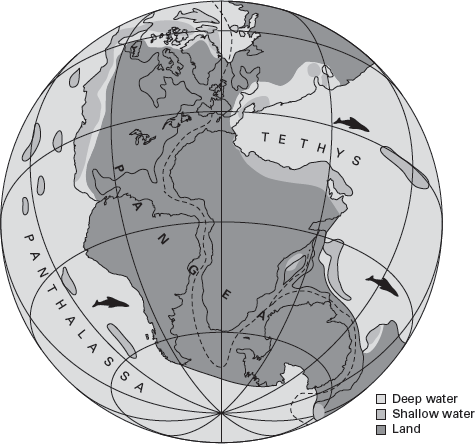
FIGURE 10.2
During the Late Triassic, the continents were united in one supercontinent, Pangea, surrounded by one ocean, Panthalassa. Tethys was a sea that indented the eastern margin of Pangea. (Drawing by Network Graphics)
By the end of the Triassic, Pangea had started to break up in the Caribbean and Mediterranean areas. Yet, the topography of Pangea during the Late Triassic seems to have been relatively subdued. There were relatively few large mountain ranges and few volcanoes.
There were no polar ice caps during the Late Triassic, and there is no evidence of glaciers or of cold, snowy winters. Indeed, climates were generally much warmer and less varied with latitude than they are today, a situation that continued for the entire age of dinosaurs. Recent computer modeling, however, coupled with rock and fossil evidence, indicates that Late Triassic Pangean climates were strongly monsoonal.
The global climate of Pangea was a true monsoon. There were only two seasons, one wet, the other dry. The abundant rainfall would have been concentrated in the summer months, and there would have been little annual temperature fluctuation. The key to the Pangean monsoon was the presence of large landmasses just north and south of the equator. During the Northern Hemisphere summer, the northern landmass would have become relatively hot, whereas the southern landmass would have been relatively cool. Moisture from the world ocean, particularly the equatorial seaway called Tethys that divided the eastern part of Pangea, would have been pulled into the Northern Hemisphere low-pressure cell, producing extensive rains, whereas the southern hemisphere high-pressure cell would have remained relatively dry. During the Southern Hemisphere summer, this process would have occurred in reverse. Thus, seasonality across Pangea would have consisted of alternating, hemisphere-wide wet and dry seasons.
The Late Triassic seas were warm and shallow, except for the far offshore portions of Panthalassa, from which few rocks and fossils have been preserved. Clams and snails were particularly common as the dominant bottom dwellers in the Late Triassic seas, as were the ammonoid cephalopods (
figure 10.3). Corals built low, mound-like reefs in many parts of the Late Triassic seafloor.
Calcareous nannoplankton, minute plant protists that secrete a calcium carbonate shell, first appeared during the Late Triassic. Sharks and heavily scaled bony fishes were successful predators in the Late Triassic seas. Long-necked marine reptiles, called
plesiosaurs, first appeared during the Late Triassic, and
ichthyosaurs, a remarkable case of evolutionary convergence of reptiles with fish-like bodies, were abundant and diverse during the Late Triassic. Indeed, the largest animal known to have lived in the Late Triassic seas was
Shonisaurus, a 10-meter-long ichthyosaur (
figure 10.4).
FIGURE 10.3
Ammonoids were successful in the Mesozoic seas. These small Late Triassic ammonoids are characteristic.
FIGURE 10.4
The 10-meter-long ichthyosaur Shonisaurus was the largest animal in the Late Triassic seas. (© Scott Hartman)
Late Triassic vegetation was very different from present-day vegetation. Ferns and the now-extinct seed ferns dominated the understory. The trees that stood above them included cycads and cycadeoids, conifers, and ginkgoes. These kinds of plants, all of which survive today—although cycads and ginkgoes are very rare—belong to a group of plants having exposed seeds called
gymnosperms.
FIGURE 10.5
The palm-like Late Triassic plant Sanmiguelia is thought by some paleontologists to have been an angiosperm. (Drawing by Network Graphics)
Most paleontologists believe flowering plants, called
angiosperms, in which the seed is covered, did not evolve until the Early Cretaceous. But there is one Late Triassic plant,
Sanmiguelia, that looks remarkably like a palm, which is a primitive type of angiosperm (
figure 10.5). This has led some paleontologists to argue that flowering plants first evolved during the Late Triassic. However, even if this were true, the Late Triassic landscape was dominated by ferns, conifers, and other types of plants now extinct or nearly extinct.
Dinosaurs appeared in a world dominated by large (up to 2-meter-long) amphibians (the
metoposaurids) and a variety of archosaurian reptiles, especially the meat-eating
rauisuchians and phytosaurs and the plant-eating aetosaurs (
figure 10.6). One of the largest meat-eaters of the Late Triassic was a rauisuchian, the 5-meter-long
Postosuchus. Other plant-eaters common when dinosaurs first appeared were rhynchosaurs and dicynodonts, two groups of reptiles well adapted to eating tough, fibrous vegetation that became extinct soon after the appearance of dinosaurs. Indeed, these types of reptiles and amphibians, as well as many of the archosaurs, became extinct close to the end of the Triassic. This was one of the major extinctions of the Mesozoic (
box 10.1).
Other land animals of the Late Triassic include the first turtles, pterosaurs, and mammals, groups that appeared nearly simultaneously with the dinosaurs. Indeed, the Late Triassic was an important turning point in the history of life on land, with many new types of animals appearing and several other types suffering extinction.
FIGURE 10.6
Phytosaurs (left) shared most Late Triassic landscapes with early dinosaurs. (© Doug Henderson)
Dinosaurs had a nearly worldwide distribution during the Late Triassic. But, they were neither conspicuous nor abundant during the Late Triassic, except perhaps at the very end of the Triassic when they were extremely common in some fossil deposits.
Most Late Triassic dinosaurs were relatively small (up to 6 meters long) and included Herrerasaurus-like predators and Lesothosaurus-like plant-eaters, although the large prosauropods, like Plateosaurus, were plant-eaters as much as 8 meters long. Unlike their contemporaries, the Late Triassic dinosaurs had an upright limb posture designed to make them fast bipedal and quadrupedal walkers and runners. Some paleontologists argue that this gave the dinosaurs an edge over other reptiles and explains why they survived and prospered after the Triassic when many other types of reptiles became extinct. Others suggest that a change in vegetation and an increasingly arid climate favored the dinosaurs during the Late Triassic and Jurassic while bringing about the extinction of the other reptiles. Whichever explanation is accepted, dinosaurs did not truly dominate the land until after the end of the Triassic.
Paleontologists identify the extinctions at the end of the Triassic as one of the five great mass extinctions of the past 540 million years (see
figure 16.1). In the sea,
ammonoid cephalopods almost became extinct, the reef community collapsed in the Tethys, and an important group of plankton—the plant protists called radiolarians—were severely impacted. As Pangea began to split apart during the Late Triassic, extensive volcanism took place around the opening Atlantic Ocean. This produced one of the great volcanic fields of Earth history, which geologists call the Circum-Atlantic Magmatic Province (CAMP). Most paleontologists believe that CAMP volcanic eruptions produced ash and gasses that altered world ocean chemistry and likely caused the Late Triassic extinctions in the seas.
BOX FIGURE 10.1
The crocodile-like phytosaurs, represented by this 1-meter-long skull, suffered extinction at about the end of the Triassic.
The end-Triassic extinctions on land were much less severe. Land plants suffered no extinctions, nor did insects. Tetrapod extinctions eliminated many groups of Triassic archosaurs, such as the rauisuchians, phytosaurs, and aetosaurs discussed in
chapter 4 (
box figure 10.1). The large amphibians (notably the metoposaurs) also suffered substantial extinctions, as did the synapsids (mammal-like reptiles). However, a careful examination of the timing of the tetrapod extinctions shows that they were spread out over several million years. Indeed, some of the marine extinctions were similarly “spread out” over a few million years. The conclusion is that the 5 million years that encompass the Triassic–Jurassic boundary was a time of accelerated extinction rates among several groups of organisms. There was no single mass extinction.
During the Early and Middle Jurassic, 201 to 163 million years ago, dinosaurs became the largest and most successful group of land vertebrates. But, the fossil record of the establishment of dinosaur dominance is not as complete as is the record from the Late Triassic and Late Jurassic. This is partly because vast deserts covered parts of Pangea during the Early and Middle Jurassic, especially in western North America and southern Africa, and few dinosaur fossils other than footprints are found in the resulting eolian rocks (
figure 10.7). Another reason we know less about Early and Middle Jurassic dinosaurs than about earlier or later dinosaurs is simply a lack of exploration. This has begun to change, however, so that new discoveries of Early and Middle Jurassic dinosaurs have been among the most significant discoveries of the past few decades.
By the end of the Middle Jurassic, Pangea had broken apart to the point where Laurussia and Gondwana were connected only in the western Mediterranean (
figure 10.8). Nevertheless, the Pangean monsoonal circulation of the Late Triassic still influenced climate across the vast supercontinent. Highly arid climates developed in parts of Pangea during the Early and Middle Jurassic. This was especially true in western North America, which was covered by a vast sand sea during much of this time.
FIGURE 10.7
Eolian sandstones, cross-bedded by wind, are the most common Lower and Middle Jurassic rocks in western North America.
FIGURE 10.8
By the Middle Jurassic, Gondwana and Laurussia were almost completely separated. (Drawing by Network Graphics)
Early and Middle Jurassic seas were populated by animals similar to those that inhabited the Late Triassic seas, except that most Jurassic animals were larger than their Triassic predecessors. Ammonoids and radiolarians recovered from the Late Triassic extinctions. The reef communities also rebounded to build the first truly large reefs of the Mesozoic. Some of the Triassic marine reptile groups became totally extinct, but ichthyosaurs and plesiosaurs persisted as particularly important marine predators. Thus, huge plesiosaurs were the largest marine predators of the Early and Middle Jurassic (
figure 10.9).
FIGURE 10.9
Three-meter-long plesiosaurs were the largest animals in the Early and Middle Jurassic seas. (Drawing by Network Graphics)
FIGURE 10.10
Cycads (the stalk-like trees behind the dinosaur) were the dominant trees of the Jurassic. (© Doug Henderson)
Cycads, cycadeoids, conifers, and gingkoes were the trees of the Early and Middle Jurassic, as they had been during the Late Triassic. Cycads today are rare tropical trees that somewhat resemble palms. However, cycads were the dominant small trees throughout the Jurassic (
figure 10.10), and paleontologists who study fossil plants call this period in Earth history “the age of cycads.” Seed ferns had become extinct by the end of the Triassic, and ferns were not as common during the Early and Middle Jurassic as they had been during the Late Triassic, possibly in part because climates worldwide may have been drier.
Dinosaurs dominated life on land during the Early and Middle Jurassic. The archosaurs that dominated Triassic landscapes—rauisuchians and phytosaurs, among others—were extinct, and most of the large amphibians had also disappeared. All of the large meat- and plant-eaters were dinosaurs. Examples include
Dilophosaurus, a 6-meter-long theropod, and
Datousaurus, a 12-to-14-meter-long sauropod (
box 10.2). All other terrestrial vertebrates of the Early and Middle Jurassic were relatively small animals, such as mammals, pterosaurs, turtles, crocodiles, and so forth. Clearly, dinosaurs had come to rule the landscape.
The most important Middle Jurassic dinosaur locality known lies just outside the city of Zigong in Sichuan Province in southern China. Chinese geologists discovered this locality in 1972, and since then, the bones of many dinosaurs and a variety of other vertebrates have been excavated from an area of more than 1,800 square meters. Many complete dinosaur skeletons were removed from the Zigong locality, but many more were left in the ground and excavated in relief for viewing by visitors to the Zigong Dinosaur Museum, built over the dinosaur locality and opened in 1987. The idea of building an exhibition facility over an ongoing dinosaur excavation was borrowed from Dinosaur National Monument in Utah, and the Zigong Dinosaur Museum may truly be called China’s dinosaur national monument.
BOX FIGURE 10.2
The primitive sauropod dinosaur Shunosaurus is known from the Zigong dinosaur quarry. (© Scott Hartman)
The Middle Jurassic dinosaurs from Zigong include the oldest and most primitive stegosaur (
Huayangosaurus) and two sauropods,
Datousaurus and
Shunosaurus (
box figure 10.2). These sauropods were much smaller than the Late Jurassic sauropods, but the composition of the Zigong dinosaur quarry—consisting mostly of sauropods and stegosaurs—is very similar to that of the great dinosaur quarries of Late Jurassic age in the western United States. This suggests that this composition of dinosaur communities, particularly the dominance of plant-eating sauropods and stegosaurs, was a feature of both the Middle and the Late Jurassic world. The Zigong dinosaurs also indicate that stegosaurs had already evolved by the Middle Jurassic. This Chinese dinosaur locality thus provides a unique glimpse of the dinosaurs of the Middle Jurassic.
Unlike the earlier part of the Jurassic, paleontologists have unearthed an extensive fossil record of dinosaurs and other organisms that lived during the Late Jurassic, 145 to 163 million years ago. This record indicates that very large land animals, the giant sauropod dinosaurs, first evolved during the Late Jurassic. This aspect of the Late Jurassic dinosaurs, as well as their wide geographic range, variety, and abundance is the reason the Late Jurassic is called the “golden age of dinosaurs.”
By the Late Jurassic, Laurussia and Gondwana were totally separated by the Tethys Sea and its westernmost extremity, the young Gulf of Mexico (
figure 10.11). Tethys was tropical and full of coral reefs. World sea level was high, and much of Laurussia and significant parts of Gondwana were inundated by seawater. This created what are called
epicontinental seas, seas situated atop continental crust, unlike today’s oceans and seas, which are mainly situated atop the denser oceanic crust.
Climates during the Late Jurassic were still influenced by the monsoonal circulation pattern of earlier times, but less so as Pangea broke up and a circum-equatorial seaway (Tethys) began to influence ocean and air circulation patterns. Overall, Late Jurassic climates seem to have resembled those of the Early and Middle Jurassic but were warmer and wetter.
FIGURE 10.11
Laurussia and Gondwana were totally separated by the Late Jurassic. (Drawing by Network Graphics)
Life in the sea and vegetation on land during the Late Jurassic were generally similar to those of the Early and Middle Jurassic. Some new marine organisms appeared, including oysters and sea urchins. Late Jurassic sea bottoms thus looked more modern than earlier Mesozoic seafloor communities. Extensive reefs were built on Late Jurassic seafloors, probably the result of higher sea levels. Plants adapted to warm climates lived as far poleward as 60 degrees north, as can be seen in the Upper Jurassic fossil floras found in Siberia.
Late Jurassic dinosaurs are well known, especially from the western United States, southern China, and eastern Africa. Huge sauropods, large stegosaurids, and small to medium-size ornithopods were the dominant plant-eaters. Megalosaurs and carnosaurs were the big meat-eaters. Almost all other land vertebrates were relatively small (some crocodiles were an exception), truly dwarfed by the gigantic dinosaurs. Dinosaur domination of the earth was complete, and the zenith of dinosaurian evolution had in many ways been reached (
figure 10.12).
FIGURE 10.12
Gigantic sauropods, such as Diplodocus, lived during the Late Jurassic. (Drawing by Network Graphics)
The Jurassic Period did not end with significant extinctions. Nevertheless, the Early Cretaceous, 100 to 145 million years ago, was a time of profound changes in the history of life on land, for it was during the Early Cretaceous that flowering plants appeared and began their rise to dominance among land plants. This change in vegetation may lie at the core of a major transition in dinosaur evolution that took place during the Early Cretaceous.
Worldwide sea level continued to rise from the Late Jurassic into the Early Cretaceous, inundating more of the continents. Gondwana finally fragmented, and the southern Atlantic Ocean began to form (
figure 10.13).
World climates became even warmer and much wetter, producing a global greenhouse climate that persisted throughout most of the Cretaceous. Indeed, high sea levels worldwide were a primary cause of the global greenhouse climate. The world was warm, equable, and ice-free, and the pole-to-equator temperature gradient during the Cretaceous, by one estimate, was only about 20 degrees Celsius. Today, it is 41 degrees Celsius.
The Early Cretaceous saw the diversification of new types of plankton, especially those types that are now common in the world’s oceans. Notable is the rise of diatoms, silica-secreting plant protists, an important component of modern oceanic plankton. Modern types of bony fishes, the teleosts with their short jaws and symmetrical tails, appeared. Predatory snails and crabs and clams that burrow into the seafloor began to diversify. Ammonoids were abundant and diverse. Whereas corals had been the dominant reef builders of the Triassic and Jurassic, during the Early Cretaceous, the
rudists, a group of clams, took center stage in building reefs (
figure 10.14).
FIGURE 10.13
During the Early Cretaceous, Gondwana fragmented, and the South Atlantic Ocean basin opened. (Drawing by Network Graphics)
Although the gymnosperm floras of the Triassic and Jurassic continued to dominate the land well into the Cretaceous, flowering plants (angiosperms) were to take over rapidly (
figure 10.15).
During the Early Cretaceous, conifers stole dominance from the cycads, thus ending the Jurassic “age of cycads.” But, about 100 million years ago, near the end of the Early Cretaceous, angiosperms first appeared, and by the Late Cretaceous, they were more diverse than the conifers. Today, there are about 100,000 species of angiosperms and only about 550 species of conifers.
Angiosperms provide a food supply for their seeds, whereas gymnosperms, such as conifers, do not. Also, angiosperm flowers attract insects that carry their pollen to other flowers, fertilizing them. These have been the keys to angiosperm success.
FIGURE 10.14
During the Cretaceous, reefs, like this cliff-forming one in southwestern New Mexico, were built by rudist clams.
FIGURE 10.15
Flowering plants first appeared near the end of the Early Cretaceous, and by the end of the Cretaceous, as shown here, they dominated the landscape. (© Doug Henderson)
Dinosaurs of the Early Cretaceous differed somewhat from those of the Late Jurassic. Ornithopods (for example, Iguanodon) were generally larger, and sauropods were generally smaller. Nodosaurid ankylosaurs first became common at this time, whereas stegosaurs virtually disappeared. Indeed, by the end of the Early Cretaceous, almost all of the primitive ornithopods, iguanodonts, and sauropods (except those in South America) had joined the stegosaurs in practically becoming extinct. Most other land vertebrates of the Early Cretaceous were rather similar to those of the Late Jurassic, but significant changes took place among mammals. Specifically, placental and marsupial mammals first appeared near the end of the Early Cretaceous.
A major change in global climate and vegetation took place during the Early Cretaceous, so it is not difficult to understand the profound transition in dinosaurs that we see between the end of the Jurassic and the beginning of the Late Cretaceous. Dominant Late Jurassic dinosaurs—the sauropods, stegosaurs, primitive ornithopods, and iguanodontians—gave way to a totally different dinosaur fauna, a transition that occurred in the Early Cretaceous.
Dinosaurs of the Late Cretaceous, 66 to 100 million years ago, were very different from the dinosaurs of the earlier portions of Mesozoic time. New types of dinosaurs appeared during the Late Cretaceous, many of them plant-eaters possibly better adapted to feeding on angiosperms than were the plant-eating dinosaurs of the Late Jurassic. These new types of dinosaurs dominated the landscape until all dinosaurs became extinct at the end of the Cretaceous.
By Late Cretaceous time, Gondwana had separated into its constituent continents, and Laurussia was split significantly by the enlarging of the northern Atlantic Ocean basin (
figure 10.16). Sea level was at an all-time high, and most of the continents had been drowned by epicontinental seas. A huge outpouring of lava took place in India (the Deccan traps).
Climates worldwide were hot and wet like a greenhouse. Tropical and subtropical zones are estimated to have extended as far poleward as 45 degrees north and 70 degrees south. Fossil leaves of warm-adapted plants are known from Upper Cretaceous rocks in Alaska, Greenland, and Antarctica. Indeed, one paleontologist has aptly described the Late Cretaceous world as “wall-to-wall Jamaica.” Near the end of the Cretaceous, however, this began to change as global sea levels fell again.
FIGURE 10.16
By the Late Cretaceous, Laurussia and Gondwana were almost completely fragmented, and sea levels were elevated worldwide. (Drawing by Network Graphics)
The Late Cretaceous seas saw the continuing diversification of modern types of marine life—certain plankton, bony fishes, crabs, and snails—that had begun during the Early Cretaceous. It also saw the end of some very successful groups, including the ammonoids and the rudist and inoceramid (plate-like) clams. A group of marine animals unique to the Late Cretaceous was the mosasaurs, large marine lizards that were also at the top of food chains in the Late Cretaceous seas (
figure 10. 17).
Flowering plants diversified rapidly during the Late Cretaceous. By the end of the Cretaceous, they had virtually replaced the gymnosperms as the dominant land plants.
FIGURE 10.17
Mosasaurs were giant marine lizards (some more than 10 meters long) of the Late Cretaceous. (Drawing by Network Graphics)
Dinosaurs of the Late Cretaceous were mostly hadrosaurid ornithopods, ceratopsians, ankylosaurs, tyrannosaurids, and abelisaurid theropods. Sauropods were common only in South America. These dinosaurs coexisted with turtles, crocodiles, lizards, mammals, and other, smaller vertebrates. They were generally not as large as some of those of the Late Jurassic, but they appear to have been more diverse and were very widespread (
box 10.3).
If we think of each successive and distinct association of dinosaurs during the Mesozoic as a dinosaur fauna, we can recognize five such faunas:
1. The Late Triassic dinosaur fauna, dominated by relatively small meat-eaters and plant-eaters along with some large prosauropods
2. The Early and Middle Jurassic dinosaur fauna, consisting mostly of sauropods, stegosaurs, and small ornithopods
3. The Late Jurassic dinosaur fauna, generally similar to that of the Early and Middle Jurassic, but including many large sauropods and theropods
4. The transitional Early Cretaceous dinosaur fauna, in which ankylosaurs and large ornithopods dominated, whereas the numbers of sauropods and stegosaurs dwindled
5. The Late Cretaceous dinosaur fauna, dominated by hadrosaurs, ceratopsians, ankylosaurs, abelisaurids, and tyrannosaurids
These five dinosaur faunas reflect changing environments and organisms throughout the 160 million years of the age of dinosaurs. They thus indicate that much evolution and extinction of dinosaurs took place during the Mesozoic.
Dinosaur fossils were first reported from the Arctic in 1962, when they were discovered in Svalbard (Spitsbergen). By the 1990s, numerous dinosaur localities, mostly of Late Cretaceous age, were known from the Arctic, especially the North Slope of Alaska (
box figure 10.3). Dinosaur fossils were also discovered in Antarctica. In 1986, scientists from Argentina discovered fragmentary remains of an ankylosaur in Upper Cretaceous rocks on James Ross Island, off the Antarctic Peninsula. Three years later, British scientists discovered fossils of an ornithopod from nearby Vega Island.
The meager record of Antarctic dinosaurs has been growing with further exploration, and it already is of importance because it documents the existence of nearly polar dinosaurs in the Southern Hemisphere during the Late Cretaceous.
Due to the drifting of the continents, reconstructions of the position of Antarctica during the Late Cretaceous suggest that the Antarctic dinosaur localities were just north of 60 degrees south then, which is only a few degrees north of their present location. There is no evidence of a polar ice cap in Antarctica during the Late Cretaceous. But, because of the tilt of Earth’s axis, Antarctica would have experienced months of virtual darkness during the Late Cretaceous winters, just as it does today. This polar winter would have been a cold one, even during the Late Cretaceous when there was no Antarctic ice cap.
How did dinosaurs, which we usually think of as warm-weather animals, survive in Antarctica during the Late Cretaceous? Two possibilities exist. One is that contrary to popular belief, dinosaurs were not just warm-weather animals, but were warm-blooded, like living mammals and birds, and thus could endure very cold temperatures. The evidence for warm-blooded dinosaurs, however, is debatable (see
chapter 14). A more likely solution to the puzzle of Antarctic dinosaurs may be that dinosaurs did not live there year round, but undertook seasonal migrations, as birds do today.
BOX FIGURE 10.3
Dinosaur fossils are known from numerous localities in the Arctic. (© Scott Hartman)
1. Dinosaurs appeared during the Late Triassic when all the continents were united in a single supercontinent, Pangea.
2. Climates on Late Triassic Pangea were warm and monsoonal, and the vegetation was dominated by ferns and gymnosperms.
3. Dinosaurs were not the dominant land vertebrates of the Late Triassic; other archosaurs were.
4. Various archosaurs and many other land vertebrates became extinct at about the end of the Triassic.
5. Dinosaurs established themselves as the dominant land vertebrates by the end of the Middle Jurassic.
6. Early and Middle Jurassic plant-eating dinosaurs were mostly prosauropods, sauropods, and stegosaurs.
7. The Late Jurassic was the golden age of dinosaurs; huge sauropods, stegosaurs, primitive ornithopods, megalosaurs, and allosaurs were the dominant dinosaurs.
8. During the Early Cretaceous, dinosaurs were in transition, as vegetation changed and the world climate became wetter and warmer.
9. The Late Cretaceous dinosaurs were mostly hadrosaurs, ceratopsians, ankylosaurs, abelisaurs, and tyrannosaurids.
ammonoid
angiosperm
dinosaur fauna
epicontinental sea
equable
Gondwana
greenhouse
gymnosperm
ichthyosaur
Laurussia
metoposaurid
monsoonal
Pangea
Panthalassa
plesiosaur
rauisuchian
rudist
Sanmiguelia
Tethys Sea
1. Describe world geography during the Late Triassic and how it changed during the age of dinosaurs.
2. How did the world climate change during the age of dinosaurs?
3. What major changes in vegetation took place during the age of dinosaurs? How might these changes have influenced dinosaur evolution?
4. What were the five dinosaur faunas of the age of dinosaurs, and how did they differ from each other?
Behrensmeyer, A. K., J. D. Damuth, W. A. DiMichele, R. Potts, H.-D. Sues, and S. L. Wing. 1992. Terrestrial Ecosystems Through Time. Chicago: University of Chicago Press. (Provides a detailed review of Mesozoic terrestrial vegetation, animal life, and climate on pp. 327–372)
Colbert, E. H. 1965. The Age of Reptiles. New York: Norton. (Somewhat outdated, but otherwise an excellent review of Mesozoic life)
Currie, P. J., and E. B. Koppelhaus, eds. 2005 Dinosaur Provincial Park: A Spectacular Ancient Ecosystem Revealed. Bloomington: Indiana University Press. (A collection of 28 technical articles on one of the world’s greatest Late Cretaceous dinosaur ecosystems)
Foster, J. 2007. Jurassic West: The Dinosaurs of the Morrison Formation and Their World. Bloomington: Indiana University Press. (Everything you want to know about the most famous Late Jurassic dinosaurs and their environment)
Fraser, N. 2006. Dawn of the Dinosaurs: Life in the Triassic. Bloomington: Indiana University Press. (Very readable review of the Triassic world and its biota)
Gee, C. T., ed. 2010. Plants in Mesozoic Time: Morphological Innovations, Phylogeny, Ecosystems. Bloomington: Indiana University Press. (A collection of 14 technical articles presenting recent research on Mesozoic plants)
Godefroit, P., ed. 2012. Bernissart Dinosaurs and Early Cretaceous Terrestrial Ecosystems. Bloomington: Indiana University Press. (A collection of 33 technical articles on Bernissart and much more about Early Cretaceous dinosaurs and ecosystems)
Hallam, A. 1965. Jurassic Environments. Cambridge: Cambridge University Press. (Provides an overview of the Jurassic world)
Lucas, S. G. 2013. The end-Triassic extinction, pp. 475–486, in N. MacLeod, J. D. Archibald, and P. S. Levin, eds., Grzimek’s Animal Life Encyclopedia. Vol.2, Extinction. Detroit: Gale Cengage Learning. (Review of the end-Triassic extinctions and their possible causes)
Novas, F. E. 2009. The Age of Dinosaurs in South America. Bloomington: Indiana University Press. (Comprehensive review of the Mesozoic history of an entire continent)
Russell, D. A. 1989. An Odyssey in Time: The Dinosaurs of North America. Toronto: University of Toronto Press. (A colorful review of the geological and environmental context of North American dinosaurs)
Stanley, S. M., and J. A. Luczaj. 1989. Earth System History. New York: Freeman. (An introductory-level college textbook that provides an overview of fossils and the history of life)
Sues, H.-D., and N. C. Fraser. 2010. Triassic Life on Land: The Great Transition. New York: Columbia University Press. (Describes the Triassic rise of modern terrestrial ecosystems)





